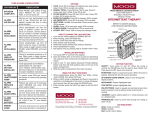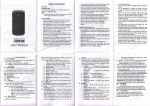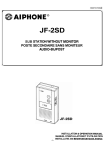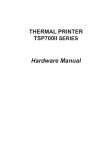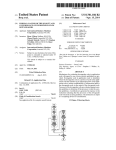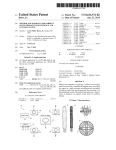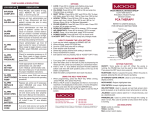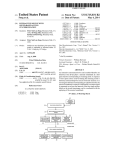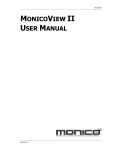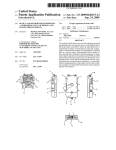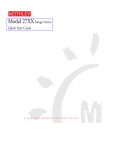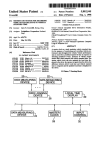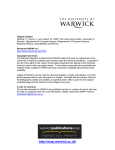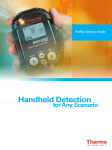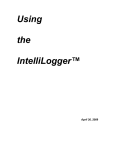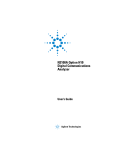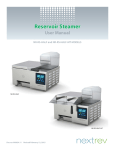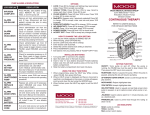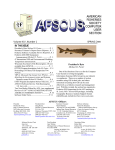Download Clinical assessment and diagnostic tool for use with peristaltic pump
Transcript
US 20040064435A1
(19) United States
(12) Patent Application Publication (10) Pub. No.: US 2004/0064435 A1
(43) Pub. Date:
Moubayed et al.
(54) CLINICAL ASSESSMENT AND DIAGNOSTIC
Apr. 1, 2004
Publication Classi?cation
TOOL FOR USE WITH PERISTALTIC PUMP
(51)
Int. Cl? ..................................................... .. G06F 7/00
(76) Inventors: Ahmad-Maher Moubayed, Mission
Viejo, CA (US); David Norman White,
San Juan Capistrano, CA (US); Linda
(52)
Us. 01. ................................................................ .. 707/1
Thomas, Laguna Niguel, CA (US);
Chuck Grey, Irvine, CA (US);
Mehryar Michael Parsee, Los Angeles,
CA (US)
(57)
Correspondence Address:
Kit M. Stetina
STETINA BRUNDA GARRED & BRUCKER
Suite 250
75 Enterprise
Aliso Viejo, CA 92656 (US)
(21) Appl. No.:
10/459,079
(22) Filed:
Jun. 11, 2003
Related US. Application Data
(63) Continuation-in-part of application No. 10/205,965,
?led on Jul. 26, 2002.
ABSTRACT
A method of storing on a remote storage device protocol
information for a drug for administration via a peristaltic
pump is disclosed. A communications path betWeen the
peristaltic pump and the remote storage device is provided.
The protocol information for the drug is entered into the
peristaltic pump. The protocol information is transferred
from the peristaltic pump to the remote storage device. The
protocol information for the drug is stored on the remote
storage device. History information may be retrieved from
the peristaltic pump. A user request is received requesting
retrieval of history information from the peristaltic pump. A
pump request is formatted to retrieve history information.
The pump request to receive history information is trans
mitted to the peristaltic pump. The history information is
received from the peristaltic pump. The history information
can be displayed and/or stored.
Patent Application Publication
u
Apr. 1, 2004 Sheet 1 0f 13
US 2004/0064435 A1
Patent Application Publication
Apr. 1, 2004 Sheet 2 0f 13
Clinical Management System
Curlin Medical. LLC
ijfgégliijjj mid Nunbuul?-llem Immigrant
GUBllN MEDIUM.
/
102
US 2004/0064435 A1
Patent Application Publication
Apr. 1, 2004 Sheet 3 0f 13
SuluuiuPwsuiplim-L
J
US 2004/0064435 A1
‘:1
lUuits:
ml
'
Lame I
l'wrc-his-hrl
Infuse 600 mg (
Do not refrigerate medication
Do not use ?ltered sets
Protoct IV bog from light
When a Protocol is uploaded to
_
l
Momtor for slgns and symptoms of lnfecilon
Replace batiery every 3 days
the pump W Selecting "Send
Rx", pump-2 a"precau?nns"
4-—
I
WindW/Wi" appear
;]
licked
I
Fig. 3
Patent Application Publication
Apr. 1, 2004 Sheet 4 0f 13
US 2004/0064435 A1
160
:
-
.ll
be"
i
A
HLLSJ‘I.’ F114."
C'Lq lecauicns:
I
lnf'usa 50D nq (l4. 4 ml) per day F01" 7 days
\;
mn nnf. reFw-Iqarata madicatlrm
inn not use Filtaved get’!
iPMi'em'. T1? hag from light
Monitor for signs and sympfnma 0F lnf'Pc‘tlnn
"Sorta, hy
llconmemsnand
4
"Drug precautions"
_
:1
Windows
'
Patent Application Publication
Apr. 1, 2004 Sheet 5 0f 13
US 2004/0064435 A1
180
H
Cullin Medical CH5 - Create Presciption
1] Connect and turn on pump.
N 2] Select Library and fill in fields.
182
31Press BEGIN PROGRAMMING.
_se|ect Libr [y l ClicLhere to store in desiqnated Library ]
1 84/—\’/
(3' Patient Library
mibrary
Dfug Namei [Enter Drug Name Here [Alphanumeric]
1 86
_
-
Patient ID: [Enter Patient Name Here [Alphanumeric]
1
Comments: Enter Therapy Information Here
:_|
Mode:
/’x\s_/Amount To Be lnfused
1 90
Flats
—|
PIBICaUliOnSI Enter Drug Precautions Here
A
192
ll
These Precautions Will Appear in the "Precaution"
Window, Before the Program ls Uploaded Into the
\/ 4000 EMS Pump
BEGIN PROGRAMMING
Fig. 5
I
Ll
Patent Application Publication
Apr. 1, 2004 Sheet 6 0f 13
200
Curlin Medical CH5 - Data from Pump
Yes/Enter:
Down
Yes/Enter:
bio/Change
?lo/Change
20”
Yes/Enter
Yes/Enter
Yes/Enter:
Fig. 6
US 2004/0064435 A1
Patent Application Publication
Apr. 1, 2004 Sheet 7 0f 13
220
226
E L'uln Maximal L145 - "alum.- FM NIilUlll
SERIAL WEBER
mmlnlt Hm: DJ- 1:
UAIDTEIIUJ‘CE DUE DLI
HISTORY {FEET L06
2
,
11:5;71 3:
1111))1 1):
11.231'31 11;
111‘34'31 l1:
-013
232/ I'M
Ran-ms
234/
/
236
238
US 2004/0064435 A1
Patent Application Publication
Apr. 1, 2004 Sheet 8 0f 13
US 2004/0064435 A1
240
Curlin Medical CH5 - Dala horn Pump
Receiving Dala..-Ple3§¢
Options Wait :Lock 2-
CloseFori'n :l
.
Lock
Shift T01:
:2
:UFF
Hourly Tot
Clear Hrly
:OFF
:UFF
Dn Ucclu
Air Sens
Audio
PHR CK
Clin Dose
:LEJDI
:0. 5 ml
:9
:UFF
:0.0
mg
Accept
:YESKNO
ZBNDVOL 14:25 PEA Rx
Fig. 8
'
Patent Application Publication
Suluut nTllurupy.
Apr. 1, 2004 Sheet 9 0f 13
US 2004/0064435 A1
1
IThl: Lu\.._u: puL: L11: pun; -11..’ a 9711 EINF‘LZ THZPJPY 1721.
Lane I
_‘_1
?lm? azkhr-Jvnal p::jre.m :ezt tc this pump vi ll KIWI this wad:
‘r
i
1
i
.‘J
Flecaucm
;'A new pvoq‘ram Rent- to The pump via the Hwh' prnqra.
:will
re enable all rather modem
_*_I
Luril "lcdwal LHh l'rccawuns
new program sent to The pump via the CMS program I]
will re-anable all other modes
lhlad
Fig. 9
I
Patent Application Publication
Apr. 1, 2004 Sheet 10 0f 13
US 2004/0064435 A1
wcNo0(tm{?QoewNh0mu6oweB:a
P
w2.32E
Now BuQRnow
.t o>
wt
N?
or
.5
8
Patent Application Publication
Apr. 1, 2004 Sheet 11 0f 13
US 2004/0064435 A1
STOP THERAPY :0.0 ml
REPEAT Rx
ON PUMP
OFF PUMP
STOP PUMP
=0.0 ml
:REPLACE SET4
19:27 ALARM
19:27 ml/VINT/PSI
:0.0/2.6/17.6
19 :27 START PUMP
:O . 0 m1
19:27 START THERAPY
19:27 RUN/PAUSE KEY
O6FEBO2 19:27 TPN RUN OPTION
O6FEBO2
O6FEBO2
O6FEBO2
O6FEBO2
O6FEBO2
O6FEBO2
O6FEBO2
O6FEBO2
O6FEBO2
O6FEBO2
O6FEBO2
19:42
19:42
19:42
19 :27
19:27
Options
:Lock 2
Lock
:2
Hourly Tot
Clear Hrly
DN Ramp
:OFF
:OFF
:OFF
Dn Occlu
Air Sens
Audio
:HIGH
:2. 0 ml
:5
PWR CK
:OFF
Accept
:YES/NO
l9 : 27 TPN Rx
Bag Vol
Vol TBI
Rate
:2070 ml
:2050 ml
:l36.7 ml/hr
UP Ramp
DN Ramp
TOt Time
:l : OO
HHzMM
:1 : OO
HH:MM
:16:OO HHzMM
KVO Rate
:O.l
Done?
:YES
O6FEBO2 19 :27 TPN PRE RX
Delay
Next?
O6FEBO2 19 :27 REPEAT RX
O6FEBO2 19:16 EXIT PRIME
Fig. 11
:OFF
:YES
:O . 0 ml
ml/hr
Patent Application Publication
3>592m;wu8?i:.2m_o0s>vwm
Apr. 1, 2004 Sheet 12 0f 13
US 2004/0064435 A1
532%13.52%;.?
F
.3251
mOwhQNMnWtFoP
NP
u?S2or3:52. 25 mcui2IoZmQ .5
Patent Application Publication
Apr. 1, 2004 Sheet 13 0f 13
US 2004/0064435 A1
IOAPROZ 15:26 STARTPUMP :4.7 m1
IOAPROZ 15:26 BOLUS GIVEN :2.0 m1
lOAPRO2 15:26 STOP PUlVIP :4.7 m1
10APRO2 15:25 BOLUS REQUEST :007
lOA-PROZ 15:25 BOLUS STARTED1OO2
1OAPRO2 15:25 STARTPUlVlP :2.7 m1
1OAPRO2 15:25 STOP PUMP :2.7 m1
1OAPRO2 15:25 BOLUS REQUEST :006
1OAPRO2
1OAPRO2
1OAPRO2
IOAPROZ
IOAPROZ
15:22 BOLUS REQUEST :OO5
15:18 BOLUS REQUEST 1004
15:15 BOLUS REQUEST 1003
15:14 BOLUS REQUEST 1002
15:13 STARTPUMP 12.0 ml
IOAPROZ
1OAPR02
1OAPRO2
1OAPRO2
1OAPRO2
15:13 BOLUS GIVEN :2.0 n11
15:13 STOPPUlVIP 32.0 ml
15:12 BOLUS STARTED:OO1
15:12 STARTPUMP :0.0 ml
15:12 STOP PUMP :0.0 m1
10APRO2 15:12 BOLUS REQUEST :001
1OAPR02 15:12 ml/VlNT/PSI :0.0/3.1/0.0
IOAPROZ
1OAPRO2
1OAPRO2
1OAPRO2
15:12 STARTPUMP :0.0 m1
15:12 STARTTHERAPY
15:12 RUN/PAUSE KEY
15:07 PCARUNOPTION
Options
:LockOFF
Lock
OFF
Clin Dose OFF
Shi? Tot .OFF
Hourly Tot .OFF
Clear Hrly :OFF
DnOcclu :HIGH
Air Sens :2.0 m1
Audio
:9
PWRCK
.OFF
AcceptOPT :YES/NO
10APRO2 15:07 PCARX
BagVol
:250.0 m1
Basal Rate :4.0 ml/hr
Bolus
:2.0 ml
Fig. 13
Apr. 1, 2004
US 2004/0064435 A1
CLINICAL ASSESSMENT AND DIAGNOSTIC
TOOL FOR USE WITH PERISTALTIC PUMP
CROSS-REFERENCE TO RELATED
APPLICATIONS
[0001] This application is a continuation-in-part of US.
application Ser. No. 10/205,965 ?led Jul. 26, 2002, the entire
contents of Which are incorporated by reference herein.
STATEMENT RE: FEDERALLY SPONSORED
RESEARCH/DEVELOPMENT
using a mouse and keyboard. Remote programming sys
tems, such as those described above may be dif?cult to
program and do not reduce infusion errors.
[0008]
programming errors and subsequently infusion errors. The
system should also be easy to program, i.e., should not
require signi?cant training by the clinician. Preferably, the
system and method also provide for clinical assessment and
diagnosis of the pump as it is being used for a particular
patient.
[0002] Not Applicable
COMPACT DISK APPENDIX
Thus, there is a need for a system and method for
programming a peristaltic pump Which reduces prescription
BRIEF SUMMARY OF THE INVENTION
[0009] An aspect of the present invention may be regarded
[0003] The speci?cation of the present application
as a method of storing on a remote storage device protocol
includes a compact disc appendix Which is submitted here
information for a drug for administration via a peristaltic
pump. The method provides a communications path
betWeen the peristaltic pump and the remote storage device.
With and incorporated by reference herein. The compact disc
Was created on Oct. 25, 2002 and includes a total of four (4)
?les. The ?rst ?le, “350-9008B CMS User Manual,” is a
User’s Manual for the CurlinTM Medical Clinical Manage
ment System and has a siZe of 891 Kbytes. The second ?le,
“Curlin Medical 4000 Peristaltic Pump,” is a User’s Manual
for the Curlin Medical 4000 Peristaltic Pump and has a siZe
of 2,243 Kbytes. The third ?le, “History File PCA Boluses
UCLA_SN102436,” an exemplary history ?le used to gen
erate the bolus requested vs. bolus received graph over a
given period of time shoWn in FIG. 12 and has a siZe of 55
Kbytes. The fourth ?le, “History File TPN Pressure
SN102243,” is an exemplary history ?le that Was used to
generate the line pressure graph of FIG. 10 and has a siZe
of 33 Kbytes.
BACKGROUND OF THE INVENTION
[0004] The present invention relates generally to medical
infusion pumps and more particularly to a system and
method for remotely controlling a peristaltic pump.
[0005] Traditionally infusion pumps have been used to
deliver medications and ?uids to patients by intravenous
subcutaneous or Epidural methods, according to a controlled
rate and dose schedule. Such infusion or peristaltic pumps
are knoWn in the art. Peristaltic pumps may be linear, such
as those described in US. Pat. No. 2,877,714 (Sorg, et. al),
The protocol information for the drug is entered into the
peristaltic pump. The protocol information is transferred
from the peristaltic pump to the remote storage device. The
protocol information for the drug is stored on the remote
storage device.
[0010] The protocol information may be stored in a drug
library on the remote storage device. The protocol informa
tion may be selected from the drug library and sent to the
peristaltic pump for administration to a patient. The protocol
information may be copied from the drug library to a patient
library. The protocol information may be eXported from the
drug library. The eXported protocol information may be sent
to another user, for eXample, via e-mail. The eXported
protocol information may be imported to the drug library.
The protocol information in the drug library may be edited.
[0011] The protocol information may be stored in a patient
library on the remote storage device. The protocol informa
tion may be selected from the patient library and sent to the
peristaltic pump for administration to a patient. The protocol
information may be eXported from the patient library. The
eXported protocol information may be imported to the
patient library. The protocol information in the patient
library may be edited.
991 (Canon), rotary, such as those described in US. Pat. No.
[0012] The protocol information for the drug may include
associated Warnings and precautions.
4,886,431 (Soderquist et al.) and US. Pat. No. 3,172,367
[0013]
(Kling) or curvilinear, such as is described in US. Pat. No.
US. Pat. No. 4,671,792 (Borsannyi), US. Pat. No. 4,893,
The remote storage device is a personal computer,
6,164,921 (Moubayed et al.).
such as a laptop computer. The remote storage device may
be a handheld storage device, such as a Personal Digital
[0006] The pump is normally programmed by a clinician
Assistant (PDA).
based on a speci?c patient prescription. The pump is tradi
tionally programmed through a user interface keypad on the
[0014] A current date/time and/or maintenance date may
be entered.
pump.
[0007]
There have been some efforts in the past to estab
lish capabilities of remotely programming the pump through
[0015] Pump calibration functions may be invoked.
keypad. The clinician can vieW the display of the remote
[0016] Another aspect of the present invention may be
regarded as a method for receiving history information from
a peristaltic pump. A user request is received requesting
retrieval of history information from the peristaltic pump. A
pump request is formatted to retrieve history information.
The pump request to receive history information is trans
mitted to the peristaltic pump. The history information is
received from the peristaltic pump. The history information
pump on a computer monitor and can interact With the pump
is displayed.
a modem and transferring data through telephone lines. For
eXample, MedivieW, Which is currently oWned by Baxter,
provides remote programming capabilities of the Homerun
6060 pump through a modem and telephone line, It alloWs
the clinician to vieW, at a remote location, the 6060 pump
simulated on a computer monitor With its display and
Apr. 1, 2004
US 2004/0064435 A1
[0017] The history information may be all of the history
information stored in the peristaltic pump. The history
information may be the latest prescription. The history
herein by reference. HoWever, use of other ambulatory
information may be a prede?ned amount of history infor
pumps is contemplated herein. Pumps, such as the one
shoWn in FIGS. 1A and 1B are typically stand-alone
devices used to administer medication to a patient. The
mation, e.g., four kilobytes. The history information may be
pump 10 shoWn in FIGS. 1A and 1B can be used as a
printed or exported for e-mail to others.
stand-alone pump. Additionally, the pump shoWn in FIGS.
[0018] Another aspect of the present invention is clinical
assessment and diagnostics. History information received
from a peristaltic pump may be extracted. The information
is extracted in response to a request for information. The
requested information is then extracted from the history ?le.
[0019] In exemplary embodiments the requested informa
tion may be patient side administration set (line pressure)
information or bolus request information. In the case of
bolus request information, the extracted information may
include bolus requests and medication administered in
1A and 1B can communicate With a computer, such as a
laptop computer 20 (shoWn in FIG. 1A) or a handheld
computer, such as a personal digital assistant (PDA) 30
(shoWn in FIG. 1B).
[0031] The present invention helps reduce the risk of
prescription programming errors, and thus medication
errors, reduces staff costs by providing time-ef?cient pro
gramming of the pump, facilitates remote monitoring of the
infusion process, provides an audit trail for billing, valida
tion and archival purposes, and easily integrates into exist
response to bolus requests.
ing systems. The data management functions alloW the
clinician the ability to create, select, and use protocols and
[0020] The extracted information may be displayed, saved
to a ?le, printed and/or transmitted, e.g., via e-mail. Saved
prescriptions, select and transfer personaliZed prescriptions
?les can be renamed. The extracted information may be in
a graphical format.
for Warnings, indications and instructions, compile data for
further analysis, retrieve patient-history ?les, and generate
to a PDA/PalmTM device, provide a “Drug Precautions” page
customiZed reports from a PC or Palm device.
BRIEF DESCRIPTION OF THE DRAWINGS
[0032] Preferably, the computing device 20 is a personal
[0021] These as Well as other features of the present
invention Will become more apparent upon reference to the
draWings Wherein:
[0022] FIG. 1A illustrates a ?rst embodiment of the
present invention Wherein a peristaltic pump is in commu
nication With a laptop computer;
[0023] FIG. 1B illustrates a second embodiment of the
present invention Wherein the peristaltic pump of FIG. 1A
is in communication With a handheld computing device;
[0024] FIG. 2 illustrates an example screen display shoW
ing the major functions of one embodiment of the present
invention;
computer (PC) With at least a 486 Intel® processor With a
system speed of at least 90 MHZ (megahertz). In preferred
embodiments, the computing device 20 uses a Windows@
operating system, such as Windows@ 95, 98, ME, 2000 or
NT. The computing device 20 should have at least thirty-tWo
(32) MB (megabytes) of random access memory (RAM) and
at least eight (8) MB of available storage space. The com
puting device 20 preferably includes a compact disc read
only memory (CD-ROM) drive. Preferably, the computing
device 20 includes a graphics card that is capable of a pixel
resolution of 800x600 or better (e.g., super video graphics
array (SVGA) or better). In addition to a keyboard, the
computing device 20 preferably includes a pointing device,
such as a mouse.
[0025] FIGS. 3-9 illustrate exemplary screen displays for
performing the various functions available from the display
shoWn in FIG. 2;
[0033] The pump shoWn in FIGS. 1A and 1B, like prior
art pumps includes logic (softWare) for managing the pump.
[0026] FIG. 10 is a graph illustrating line pressure for a
pump over a given period of time;
[0034] In exemplary embodiments of the present inven
tion, the computer 20 stores a drug library and a patient
[0027]
FIG. 11 is an excerpt of a history ?le used to
generate the graph shoWn in FIG. 10;
[0028] FIG. 12 is a graph illustrating bolus requested vs.
bolus received over a given period of time; and
[0029]
FIG. 13 is an excerpt of a history ?le used to
generate the graph shoWn in FIG. 12.
DETAILED DESCRIPTION OF THE
INVENTION
[0030] Referring noW to the draWings Wherein the shoW
ings are for purposes of illustrating preferred embodiments
of the present invention only, and not for purposes of
limiting the same, FIGS. 1A and 1B illustrate a peristaltic
pump in communication With a computer capable of pro
gramming the pump. The particular pump shoWn in the
library. The drug library stores protocols classi?ed by drug
name, programmer name (person Who stored the protocol),
and creation date. Aprescription or protocol can be selected
from those stored in the drug library. The prescription can
then be sent to the pump attached to the computer. The
protocol is then uploaded to the pump.
[0035] FIG. 2 illustrates an example screen display shoW
ing the major functions of one embodiment of the present
invention. Preferably, upon starting the program, the user is
asked to enter a passWord. Details in setting up passWords
and entering and validating passWord is not explained in
further detail herein as techniques knoWn in the art can be
used for security aspects of the present invention including
a user login function.
[0036]
The exemplary screen display 100 shoWn in FIG.
2 includes controls to access the major functions of the
Figures is marketed by CurlinTM Medical of Huntington
present invention. In the illustrated example, graphical
Beach, Calif. and is described in US. Letters Pat. No.
depictions of the function are selected to invoke the various
functions. It Will be appreciated that other user interface
6,164,921, the disclosure of Which is expressly incorporated
Apr. 1, 2004
US 2004/0064435 A1
controls, such as menus, could be used to access the func
tions. The selections available from the main menu shoWn in
FIG. 2 include: Drug Library 102, Patient Library 104,
Create Prescription 106, Manage History 108, Peace of
Mind 110 and Single Therapy 112. Each of theses functions
is brie?y summarized next and described in more detail later.
a prescription to the pump programs the pump With the
prescription. Pressing the Send Rx to Pump button 140
causes the precaution WindoW to display the precaution
information for the protocol. The administrator of the pre
scription must revieW the precautions and indicate that the
precautions have been revieWed by pressing the “Noted”
[0037] Pressing the Drug Library button 102 invokes the
button.
drug library function Which alloWs the user to store and
[0044]
access protocols. Pressing the Patient Library button 102
PalmTM by pressing the Select Rx for Palm button 150. In
exemplary embodiments, selection of this function saves
invokes the patient library function Which alloWs the user to
store and access (e.g., copy and export) patient speci?c
prescriptions. Pressing the Create Rx button 104 invokes the
The user may also Send a Prescription to the
library. Pressing the Manage History button 106 invokes the
selected protocols into a directory for transfer to a PalmTM
device. A cable is connected from the computer to the
PalmTM device. In exemplary embodiments, the user selects
the prescription to be sent to a HotSync folder. The ?les in
the HotSync folder can then be selected for transfer to the
manage history function Which alloWs the user to doWnload
PalmTM device. In exemplary embodiments, all of the pro
the pump history for archiving, documentation, revieW or
analysis. Pressing the Peace of Mind button 108 invokes the
peace of mind function Which doWnloads a recently pro
tocols being transferred to the PalmTM device are stored in
one ?le, for example, a ?le named Patient.pdb. This ?le is
then transferred to the PalmTM device. In exemplary embodi
grammed therapy for documentation, validation or veri?ca
tion. Pressing the Single Therapy button 110 invokes the
Written over by the neW ?le. Thus, the user must transfer all
create prescription function Which alloWs the user to enter
and store information in the drug library or the patient
single therapy function Which converts the pump into a
PCA, TPN, continuous, intermittent, or variable therapy
only pump for manual programming.
[0038] If the user presses the Drug Library button 102, an
exemplary Drug Library Display 120 such as the one shoWn
in FIG. 3 is displayed so that the user can vieW or edit
information for the prescription that Was entered during
create Rx. In the example shoWn, there is a list of stored
protocols 122 Which are identi?ed by a drug name, pro
grammer and creation date. One of the stored protocols can
be selected. Detailed information is then shoWn for the
selected protocol. The detailed information includes com
ments, if there is an existing Patient.pdb ?le, it Will be
desired protocols to the PalmTM device as the previous
protocols in an existing Patient.pdb ?le Will be overWritten.
[0045]
If the user presses the Patient Library button 104,
a patient library display 160 is displayed. In exemplary
embodiments, such as the one shoWn in FIG. 4, the patient
library display 160 and functions (invoked by controls, such
as buttons) are similar to those for the drug library. As With
the drug library, the user can import, export or edit entries in
the patient library. The user can send a prescription to the
pump or transfer prescriptions to the PalmTM device.
[0046]
Creating a prescription alloWs the user to store
controls, such as buttons, that alloW the user to manipulate
prescription information in the drug library or the patient
library. This information is uploaded from the pump. The
the data in the drug library.
user presses the Create Prescription button 106 from the
ments 124 and drug precautions 126. The display includes
[0039] In the exemplary embodiment, the user can press a
Copy button 130 Which alloWs the user to copy a protocol
from the drug library to the patient library. When the copy
button 130 is pressed, a WindoW is displayed prompting for
a patient’s name. Entry and acceptance of a valid patient
name causes the selected protocol to be copied to the patient
library and stored under the entered patient’s name.
[0040] Pressing an Import button 132 alloWs the user to
import a protocol. This alloWs the user to store appropriately
formatted ?les into the drug library. The ?les may be sent by
another user.
[0041] Pressing an Export button 134 alloWs the user to
export a selected protocol. The user can export the protocol
to another user. In exemplary embodiments, the protocol is
exported by sending it to the desired user via e-mail.
[0042]
Pressing an Edit button 136 alloWs the user to edit
an existing protocol. In exemplary embodiments, selection
of the edit function causes tWo additional controls, e.g.,
buttons, to be displayed, namely, Delete and Save. The user
can then edit the comments and/or precautions ?elds and
main display WindoW 100. Acreate prescription WindoW 180
such as the one shoWn in FIG. 5 is displayed. The exemplary
screen display shoWn in FIG. 5 provides the user With an
instruction WindoW 182 Which tells the user to: (1) connect
and turn on the pump; (2) select library and ?ll in ?elds; and
(3) program the pump.
[0047]
A cable is used to connect the pump, for example,
CurlinTM Medical 4000 CMS pump 10 is connected to the
PC 20, by inserting the cable in the serial port of the PC. The
user selects the desired library 184, i.e., the drug library or
the patient library, for storing the protocol to be uploaded
from the pump. The user also enters a drug name 186, a
patient ID 188, comments 190 and precautions 192.
[0048] The user then presses a Begin Programming button
194 and begins programming the pump. The pump is
programmed the same as during stand-alone operation of the
pump. For example, if the pump is a CurlinTM Medical 4000
Plus pump, the pump is programmed according to the
directions for that particular pump. The user’s manual for
the CurlinTM Medical 4000 Plus pump is included as a
save them by pressing the save button, if desired. In exem
compact disc appendix and is incorporated herein by refer
plary embodiments, the drug name, programmed by and
ence.
creation date ?elds cannot be edited. The user may delete a
[0049]
In exemplary embodiments, such as the one shoWn
protocol, if desired, by pressing the Delete button.
in FIG. 6, protocol information, including keystrokes that
[0043] The user may also send the prescription to the
pump by pressing a Send Rx to Pump button 140. Sending
are used When programming the pump, is stored. For
example, When a menu is displayed and the user scrolls
Apr. 1, 2004
US 2004/0064435 A1
doWn, “DOWN” is stored in the protocol ?le. Thus, When
can be automatically generated. For example, the exemplary
the information is uploaded to the pump, it is as if a user
screen display 100 shoWn in FIG. 2 may include a control
Were using the keypad to enter the information directly into
the pump except that the information is actually transmitted
from the computer via the cable that connects the pump to
the computer.
(not shoWn) for generating reports. Such a report could be
printed or displayed. In exemplary embodiments, the reports
[0050] The computer stores history ?les. Peace of mind
?les include the latest programmed prescription.
[0051] If the user presses the Manage History button 108,
[0057] One example clinical assessment and diagnostic
that can be performed is the monitoring and analysis of
are in a format that can be vieWed using external off-the
shelf programs, such as Microsoft® Excel®.
patient side administration set line pressure. For example, a
the manage history function is invoked and all of the
information stored in the pump 10 is doWnloaded to the
computer 20. A manage patient history display 220 such as
pump, such as the CurlinTM Medical 4000 pump manufac
the one shoWn in FIG. 7 is displayed. The user can either
line pressure. The monitored line pressure may be stored in
a history ?le. The line pressure information can be retrieved
choose to retrieve the patient history 222 or to retrieve and
tured by CurlinTM Technology of Huntington Beach, Calif.
may be capable of monitoring patient side administration set
then clear the patient history 224. If clear the patient history
from the history ?le and used to perform trend analysis.
is selected, the history ?le Will be deleted from the pump 10
after it is doWnloaded to the computer 20. After selecting
[0058] Various catheters may be used With the pump. For
example, the catheter may be a peripherally inserted central
one of these options, the user presses a Retrieve NoW button
226 to retrieve the data from the pump. The names and
line catheter inserted up through the patient’s arm or a
subcutaneous port catheter used With a HuberTM needle. The
creation dates of the doWnloaded history ?les are displayed
pump infuses medication into the patient via the catheter.
in an existing history ?les WindoW 228. The user can select
a history ?le from the existing history ?le WindoW 228. The
data in the selected ?le is then displayed in a vieW history
WindoW 230. There are also controls (e.g., buttons) that
alloW the user to rename 232, export 234, delete 236 or print
238 a selected history ?le.
[0052] If the user presses the Peace of Mind button 112, a
peace of mind function is invoked. The peace of mind
function doWnloads and displays the most recently pro
grammed therapy. This provides the clinician With proof (or
peace of mind) that the therapy Was uploaded into the pump.
In exemplary embodiments, this feature doWnloads the most
recent four (4) kilobytes of data from the pump history. An
exemplary screen display 240 shoWing peace of mind data
is shoWn in FIG. 8.
[0053] The present invention also alloWs the pump to be
utiliZed as a single therapy device. When the user presses the
[0059] The internal pressure (in millimeters of mercury
(mmHg)) is the infusion pressure leaving the pump and
going into the patient. In exemplary embodiments, line
pressure is continuously taken and is recorded every tWenty
minutes in the history ?le. An exemplary history ?le is
included in the CD appendix and is titled “History File TPN
Pressure SN102243.” Aportion of this history ?le is shoWn
in FIG. 11. The volume infused, voltage of the internal
battery, and internal line pressure are recorded in the history
?le every tWenty minutes.
[0060]
The data can be extracted from the history ?le to be
analyZed. The data may be plotted. For example, FIG. 10
illustrates history data plotted from the ?le included in the
CD appendix. This information can be displayed, printed
and/or saved in a ?le. In exemplary embodiments, the data
can be transmitted, for example via email. The saved ?les
Single Therapy button 112, all but one therapeutic mode on
the pump are disabled. For example, some hospitals only
can be renamed and/or deleted.
need a single mode, such as PCA. This feature can be used
This trend analysis can be used to determine if pressure is
building up. This build up of pressure indicates that there is
a restriction of the How of the medication into the patient.
The analysis can also be used to assist in predicting When the
catheter needs to be ?ushed or replaced.
When the pump is being manually programmed. In exem
plary embodiments, the user can select any available thera
peutic mode as the single mode therapy, for example,
Continuous, Intermittent, PCA, TPN, or Variable. The pump
can be removed from single therapy mode manually or by
selecting Multi therapy.
[0054] Various maintenance activities may be performed
on the pump using the present invention. For example, a
current date/time may be entered and/or a maintenance date
may be entered. The present invention may also be used to
invoke calibration functions on the pump.
[0055] In exemplary embodiments, a palm computing
device 30 may be used to perform a subset of the operations
that can be performed by larger computing devices, such as
a laptop computer 20. The Palm system can be used to
program a pump 10 or to retrieve information from the
pump. Protocols or prescriptions can be transferred to the
PDA 30 from the PC 20 for bedside pump programming.
Infusion information gathered by the pump 10 can be
doWnloaded for later analysis.
[0056] In exemplary embodiments, clinical assessments
and diagnostics can be performed. Preferably, these reports
[0061]
The plot can be used to perform trend analysis.
[0062] In FIG. 10, after starting the infusion, the average
pressure started to sloWly increase on the third and fourth
days. The pressure then dropped. This increase is likely due
to gross sedimentation from the bag occluding the admin
istration set ?lter. The pressure drop Was likely because the
bag Was replaced.
[0063]
Anomalies may also be seen in the graph. For
example, there is a large spike in the pressure. This spike
occurred immediately after starting infusion and then
dropped prior to the next pressure reading. This indicates a
problem that Was quickly corrected. For example, a slide
clamp may have been left in place Which caused the spike.
When the slide clamp Was removed, the spike drop, i.e., the
pressure returned to a normal or expected range value.
[0064]
Total Parenteral Nutrition (TPN) patients are con
cerned about occlusion of the catheter. Such an occlusion
can indicate the presence of an infection. Catheter pressure
Apr. 1, 2004
US 2004/0064435 A1
trend analysis as described above can be used to predict
catheter performance and useful life. It can help to determine
When a catheter needs to be ?ushed or replaced. This reduces
the risk of infection to the patient due to catheter inclusion.
A home healthcare professional can typically ?ush or
replace a catheter. Trend analysis for determining When a
catheter should be ?ushed or replaced may prevent unnec
essary trips to the emergency room.
[0065] Another example of a diagnostic is the analysis of
bolus requests. Hospitals typically con?gure a pump based
on a single protocol. HoWever, patients have different tol
erances to pain. Patient Controlled Analgesia (PCA) therapy
alloWs a patient to have some control over the amount of
medication received. Aprescription includes a basal amount.
The patient may also be able to receive additional medica
tion (a bolus) upon request. The bolus alloWs for a certain
amount of medication to be administered above the basal
amount. The patient has a mechanism, such as a button
Which is pressed, to request additional medication. Medica
tion is not automatically administered for each request. The
system is programmed to alloW only a certain amount of
additional medication Within a given time period.
[0066]
Bolus requests are recorded in the history ?le.
Additional medication administered in request to the bolus
request(s) is also stored in the history ?le. The bolus requests
and medication administered in response to the bolus
requests can be extracted from the history ?le. An exemplary
history ?le is in the CD Appendix (in a ?le entitled “History
File PCA Boluses UCLA_SN102436”). FIG. 13 shoWs an
excerpt of this history ?le. The extracted information can be
put in a graphical format such as that shoWn in FIG. 12.
Trend analysis can be performed in order to determine a
patient’s tolerance for pain. This information can be dis
played, printed and/or saved in a ?le. In exemplary embodi
ments, the data can be transmitted, for example via e-mail.
The saved ?les can be renamed and/or deleted
[0067] While an illustrative and presently preferred
embodiment of the invention has been described in detail
herein, it is to be understood that the inventive concepts may
be otherWise variously embodied and employed and that the
6. The method of claim 4, further comprising:
receiving a request to delete the ?le; and
deleting the ?le.
7. The method of claim 4, further comprising:
receiving a request to rename the ?le; and
renaming the ?le.
8. The method of claim 1, further comprising printing the
extracted information.
9. The method of claim 8, Wherein the extracted infor
mation is printed in a graphical format.
10. The method of claim 1, further comprising transmit
ting the extracted information.
11. The method of claim 10, Wherein the extracted infor
mation is transmitted in a graphical format.
12. The method of claim 10, Wherein the extracted infor
mation is transmitted via e-mail.
13. The method of claim 1, Wherein the requested infor
mation is patient side administration set line pressure infor
mation.
14. The method of claim 1, Wherein the requested infor
mation is bolus request information.
15. The method of claim 14, Wherein the bolus request
information includes volume of medication administered in
response to bolus requests.
16. A method for extracting bolus request data from
history information received from a peristaltic pump, the
method comprising:
receiving the history information from the peristaltic
Pump;
receiving a request to extract bolus request information
from the history ?le; and
extracting the requested bolus request information from
the history ?le.
17. The method of claim 16, further comprising display
ing the extracted bolus request information.
18. The method of claim 16, Wherein the extracted bolus
request information is displayed in a graphical format.
19. The method of claim 16, Wherein the bolus request
such variations except insofar as limited by the prior art.
information includes volume of medication administered in
response to bolus requests.
What is claimed is:
line pressure data from history information received from a
1. A method for extracting data from history information
received from a peristaltic pump, the method comprising:
peristaltic pump, the method comprising:
receiving the history information from the peristaltic
appended claims are intended to be construed to include
20. Amethod for extracting patient side administration set
receiving the history information from the peristaltic
Pump;
receiving a request for information to extract from the
history ?le; and
extracting the requested information from the history ?le.
2. The method of claim 1, further comprising displaying
the extracted information.
3. The method of claim 1, Wherein the extracted infor
mation is displayed in a graphical format.
4. The method of claim 1, further comprising saving the
extracted information in a ?le.
5. The method of claim 4, Wherein the extracted infor
mation is saved in a graphical format.
Pump;
receiving a request for the patient side administration set
line pressure information; and
extracting the requested patient side administration set
line pressure information from the history ?le.
21. The method of claim 20, further comprising display
ing the extracted patient side administration set line pressure
information.
22. The method of claim 20, Wherein the extracted patient
side administration set line pressure information is displayed
in a graphical format.
*
*
*
*
*



















